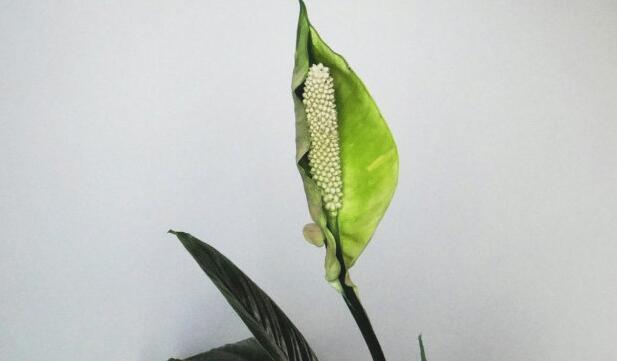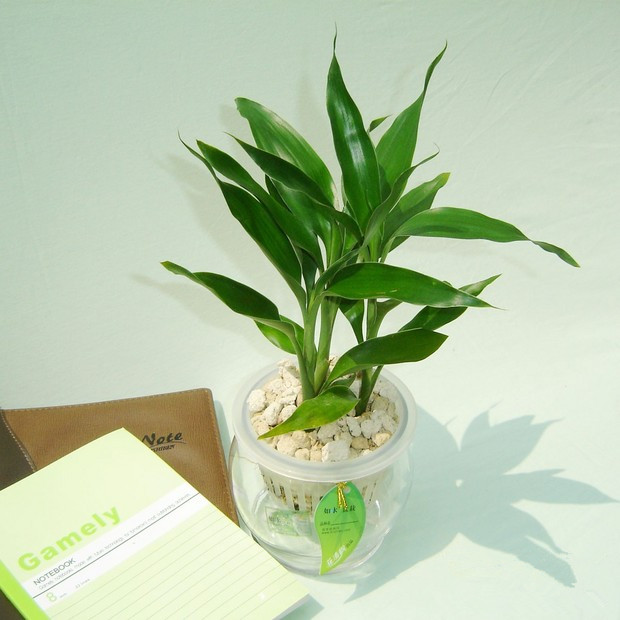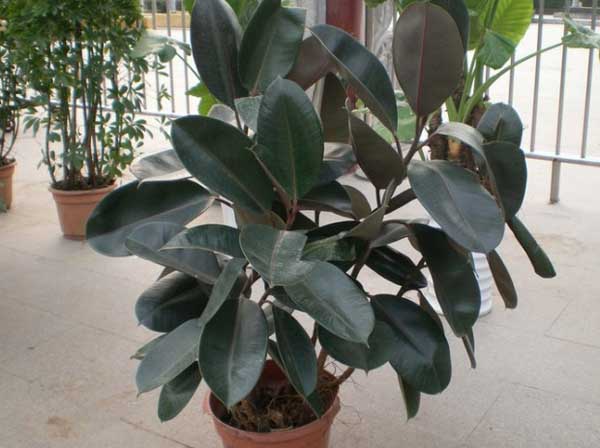Plain sailing. What are the diseases and insect pests? How to prevent and cure?
(1) disease. The common diseases are bacterial leaf spot, brown spot and blight, as well as root rot and stem rot.
There are two ways of infection of bacterial leaf spot. The first type of infection begins on leaves, which is called leaf infection. Leaf infection usually begins at the edge of the leaf and where there are many stomata in the lower part of the leaf. In the early stage, water-immersed spots can be seen on the back of the leaf, but in the later stage, brown spots appear on the edge of the leaf, and there is a yellow halo on the edge. The second type of infection begins on the stem and spreads rapidly throughout the plant through the vascular bundle system, which is called systematic infection (or vascular bundle infection).
Systematic infection can be detected by yellowing leaves, and the color of new leaves is dim at the initial stage of bacterial infection. In a short period of time, this type of infection can cause pedicels and leaves to fall off from the plant, rapid decay of the growth point, and bacterial pus overflow. Systematic infection is irreparable.
Brown spot mainly harms the leaves of plants, the disease mostly starts from the basal leaves, produces light green water-stained small round spots at the initial stage, and then gradually turns brown or black. With the passage of time, the patches gradually expand, and the damaged leaves wither, and finally scorch and die.
The symptom of the disease is that the disease occurs first in the part near the ground, and the rhizome, stem and leaf can all be damaged. Primary water stains, brown after expansion. When the humidity is high, the disease spot expands rapidly, the disease part softens the damp rot, and produces sparse white mold layer. The root and stem is infected, causing the plant to invert.
When the stem is infected, it turns back after wet rot, and the stems and leaves above the diseased part wilt or die; the leaves often expand and show yellow-brown spots, which seriously affect the ornamental effect.
For the prevention and control of bacterial leaf spot and brown spot, 75% chlorothalonil, 50% mancozeb, 50% carbendane and other agents can be sprayed at the initial stage of the disease. Its concentration is generally 800 × 1000 times aqueous solution, sprayed once every 7 days, continuously 2 times 3 times, or with 50% bactericidal king 1 000 times solution, continuously sprayed 3 times 4 times every 7 times 10 days, has a very good control effect.
The epidemic disease can be taken: ① rotation or planting with disease-free soil. ② chooses places with good drainage to plant or place flowerpots. Avoid overdense plants and ensure good ventilation and light transmission. The diseased plant was removed and burned by ③ in time. Disinfect the soil before planting and irrigate 95% Luheng No. 1 boutique 3000 times. According to the weather forecast, ④ sprayed 58% metalaxyl manganese zinc wettable powder 600x liquid or 61% ethyl phosphorus aluminum manganese zinc wettable powder 400x 500x solution before or after heavy rain, and downy mildew bengjing wettable powder 600x liquid, once every 10 days or so, depending on the weather and the incidence of the disease.
(2) insect pests. The common insect pests are mainly shell insects and red spiders.
Scale insects are one of the most common pests in flowers, which often gather on branches, leaves and fruits. The mouthparts of adults and nymphs are inserted into the leaves and branches of flowers to absorb juice, resulting in the symptoms of branch and leaf wilting and deformity, and coal fouling disease. Scale insects have strong reproductive ability and can produce many generations in a year. After a short period of crawling, that is, the shell is formed and the life is fixed, which is one of the major characteristics of scale insects. The resistance of shell insects is strong, and it is difficult for general agents to enter, so it is difficult to control them. Therefore, the appropriate period of prevention and control should be mastered. Prevention and control methods: when shell insects are found in individual leaves or branches, they can be gently brushed with a soft brush or wiped off with cotton balls and towel gourd stems; when shell insects occur in a large area, chemical control should be used, mainly during the egg incubation period. because the shell has not yet been formed or thickened at this time, kill it with a chemical. The medicament can choose 40% omethoate, 50% malathion and 80% dichlorvos EC 800 / 1000 times, sprayed every 7 to 10 days for 2 times in a row, which can effectively prevent the damage of scale insects.
In the process of flower cultivation, red spider is a common pest. This kind of insect damage way is to pierce the mouth organ into the flower leaves to suck juice, so that the flower chlorophyll is destroyed, the leaves show gray-yellow spots or patches, and the leaves become withered and yellow, or even fall off. Prevention and control methods: to prevent the harm of red spiders, we should pay attention to observe flowers at ordinary times, and carefully check the back of leaves when we find that the color of flowers is abnormal. When individual leaves are damaged, insect leaves can be removed; when more leaves are damaged, spraying should be carried out as soon as possible. The commonly used pesticides are propargite, dicofol, dimethoate, Huachongjing, and so on. A flower sprayer can be prepared for family flower growth. drop 4 drops of Huachongjing (equivalent to 2000 times liquid) in 400ml water, or drop 8 drops of dicofol or dimethoate (equivalent to 1000 times liquid), shake well after adding medicine, then spray. Spray is required to be uniform and thoughtful, especially pay attention to spraying the back of leaves.
Plain sailing long pest control, plain sailing pest control / leaf spot disease is hopeless
Because plain sailing means good, many flower friends choose to keep it indoors. However, the indoor is certainly no better than the wild, because the conditions are poor, plain sailing will be disturbed by insects, then smooth sailing will be long pest how to do? Soil, light, moisture and so on may cause plain sailing and sickness. the following is the plain sailing pest control carefully arranged by the editor. If you love flowers, you must come in and have a look.
First, plain sailing long pest how to do, find the cause

In the smooth farming methods, we introduce indoor farming, smooth sailing has requirements on soil, light, water, etc., once the standard is not up to the standard, the leaves will grow insects or get sick. As for plain sailing, what to do with bugs is actually very simple. We just need to find out what the bugs are, and then solve them. The following are the symptoms and solutions of several pests, as follows:
1. Scale insects
Shell insects, so flowers hate one of the insects, smooth sailing insects, may be it. It is understood that the insect often swarms on branches, leaves and fruits. The mouthparts of adults and nymphs are inserted into the leaves and branches of flowers to absorb juice, resulting in the symptoms of branch and leaf wilting and deformity, and coal fouling disease.
Control methods: when there are few scale insects, gently brush off with a soft brush or wipe off with cotton balls and towel gourd stems; when there are too many scale insects, you can choose 40% omethoate, 50% malathion, 80% dichlorvos EC 800-1000 times, spray every 7-10 days, continuously 2-3 times, can effectively prevent the damage of shell insects.
2. Red spider
As one of the plain sailing diseases, the red spider is very troublesome. The way it does harm is to suck the juice by piercing the mouthparts into the leaves of flowers, so that the chlorophyll of flowers is destroyed, the leaves show gray-yellow spots or patches, and the leaves become withered and yellow, even fall off.
Prevention and control methods: usually should pay attention to the observation of flowers, found that flowers leaves abnormal color, should carefully check the back of the leaves. When individual leaves are damaged, insect leaves can be removed; when more leaves are damaged, spraying should be carried out as soon as possible. The commonly used pesticides are propargite, dicofol, dimethoate, Huachongjing, and so on.
About plain sailing long pest how to do, mainly is the above content, in fact, as long as we pay more attention to maintenance, bugs will not appear. However, it doesn't matter if you are attacked by bugs, we can find the cause calmly and solve the problem. Small bugs can't afford any big waves.
Second, plain sailing disease symptoms and control methods
In addition to being attacked by insects, diseases are also something we need to pay attention to. It is understood that there are three main diseases that are smooth sailing, bacterial leaf spot, brown spot and blight, among which leaf spot is basically irreparable. The specific symptoms and solutions are as follows:
1. Brown spot
The disease is one of the main diseases of plain sailing, it mainly harms the leaves of plants, the disease starts from the basal leaves, produces light green water-stained small round spots at the initial stage, and then gradually turns brown or black, and with the passage of time, the plaques gradually expand, and the damaged leaves wither and finally scorch and die.
Prevention and treatment: at the initial stage of the disease, 75% chlorothalonil, 50% mancozeb, 50% carbendazim and other agents can be sprayed. Its concentration is generally 800 × 1000 times aqueous solution, sprayed once every 7 days for 2 times 3 times, or 50% Shawang 1000 times liquid, continuously sprayed 3 times 4 times every 7 times 10 days, has a very good control effect.
2. Bacterial leaf spot
There are two ways of infection of bacterial leaf spot: the first type of infection begins on the leaf, which is called leaf infection. Leaf infection usually begins at the edge of the leaf and where there are many stomata in the lower part of the leaf. In the early stage, water-immersed spots can be seen on the back of the leaf, but in the later stage, brown spots appear on the edge of the leaf, and there is a yellow halo on the edge.
The second type of infection begins on the stem and spreads rapidly throughout the plant through the vascular bundle system, which is called systematic infection. Systematic infection can be detected by yellowing leaves, and the color of new leaves is dim at the initial stage of bacterial infection. In a short period of time, this type of infection can cause pedicels and leaves to fall off from the plant, rapid decay of the growth point, and bacterial pus overflow. Systematic infection is irreparable.
3. Epidemic disease
The disease is characterized by leaf spot, seedling quenching, rhizome rot, crown rot, branch ulcer and rot, etc. the damaged part of the plant produces dark-brown watery spot with no obvious edge, which can quickly cause necrosis and decay of the diseased part.
Prevention and cure method: ① chooses the place with good drainage to plant or put flowerpots. Avoid overdense plants and ensure good ventilation and light transmission. The diseased plant was removed and burned by ② in time. Disinfect the soil before planting and irrigate 95% Luheng No. 1 3000 times.
White crane taro leaves wilted how to do, appropriate shade / reasonable water and fertilizer / diseases and insect pests spray
For white crane taro, flower friends should be no stranger, it is also called white palm, plain sailing, is a kind of flower loved by flower friends. In life, there are many people who keep white crane taro at home, but in the process of breeding, because of various reasons, plant leaves will wilt symptoms, then white crane taro leaves wilted how to do? Today, the editor is here to solve this problem for everyone.
First, the white crane taro leaves wilted, looking for the cause
As a common flower, the culture method of white crane taro is not difficult, but the flower friends are easy to neglect in some details, and the result is shown on the leaves, resulting in symptoms such as yellowing and wilting of white crane taro leaves. As for what to do when the white crane taro leaves wilted, the editor summarized six causes and attached solutions, and we moved on.
Second, the causes of wilting leaves of Amorphophallus and its solutions.
1. The light is too strong
White crane taro likes light, but it is afraid of strong light, so it has the best curing effect in indoor astigmatism. If in summer, people put the white crane taro in the sun, it will have an uncomfortable reaction, mainly manifested as white crane taro leaves wilting and yellow.
Solution: if the exposure time is not long, move it to the indoor shade in time to slow it down, pour a little water, and then slowly move the plant to the astigmatism for maintenance; if the exposure time is long, the plant may not be saved, so summer maintenance must pay attention to shade.
2. Temperature discomfort
Amorphophallus likes warm environment, and the most suitable growth temperature is 22-28 ℃. Once the temperature is more than 35 ℃ or lower than 5 ℃, it is easy to wilt the leaves.
Solution: in summer, plant should be moved to indoor ventilated place for maintenance, and timely watering to cool down; in winter, room temperature should be kept above 15 ℃.
3. The air is too dry
White crane taro likes a humid environment, which requires high air humidity. If the air is too dry, it will make the leaves of white crane taro wilting and unenergetic.
Solution: in the process of white crane taro growth, in addition to meeting its water requirements, water should be sprayed around the plant from time to time to increase air humidity.
4. Excessive fertilization
White crane taro likes to be fat, and sufficient nutrients can make it bloom more beautifully in the process of growth. However, we must pay attention to fertilization, fertilization can not be too much or too thick, otherwise it will produce fertilizer damage, so that the poor growth of white crane taro, the phenomenon of leaf wilting.
Solution: if the white crane taro leaves wilted caused by too much fertilization, we should irrigate in time to dilute the fertilizer and let them flow out from the bottom of the basin.
5. Diseases and insect pests
When it comes to the reason why the leaves of the white crane taro have wilted, in fact, diseases and insect pests are also a point that we need to consider. It is understood that, for example, when there are mites, the leaves of the white crane taro wilt, lose their luster and become yellow.
Solution: find out what kind of diseases and insect pests are specific, and then solve the problem by spraying. Specifically, you can refer to the pest control of white crane taro.
6. Environmental abrupt change
In addition to the above points, environmental mutation is also one of the reasons for the wilting of white crane taro leaves, which generally occurs on newly bought white crane taro potted plants. The reason for this is that the environment has changed, and the temperature and humidity have changed greatly, which can easily lead to the weakening of root absorption function and the decrease of water absorption.
Solution: at this time, we do not have to worry, this is a new pot must go through the process. Flower friends only need to meet its growth needs, and it will return to health after a period of time.
- Prev

How to raise rich bamboo in water?
Rich bamboo likes dampness and is suitable for family aquaculture. Water to raise rich bamboo is convenient and sanitary, simple and easy to do. First of all, choose robust, disease-free cuttings, cuttings should be cut into oblique incisions, in order to expand the water absorption area, but also conducive to the absorption of nutrients. It can take root about 7-10 days after insertion, and the new root is white and beautiful for viewing.
- Next

What if the lower leaves of the rubber tree turn yellow and fall off?
Rubber tree belongs to perennial evergreen woody plant of Moraceae, its leaves are thick and shiny, evergreen all the year round, some varieties' leaves and tender tips are purplish red, and the plant type is plump and elegant. The common cultivated varieties are: ① black leaf rubber tree: dark red leaves, red dorsal veins, bright red buds.
Related
- Fuxing push coffee new agricultural production and marketing class: lack of small-scale processing plants
- Jujube rice field leisure farm deep ploughing Yilan for five years to create a space for organic food and play
- Nongyu Farm-A trial of organic papaya for brave women with advanced technology
- Four points for attention in the prevention and control of diseases and insect pests of edible fungi
- How to add nutrient solution to Edible Fungi
- Is there any good way to control edible fungus mites?
- Open Inoculation Technology of Edible Fungi
- Is there any clever way to use fertilizer for edible fungus in winter?
- What agents are used to kill the pathogens of edible fungi in the mushroom shed?
- Rapid drying of Edible Fungi

